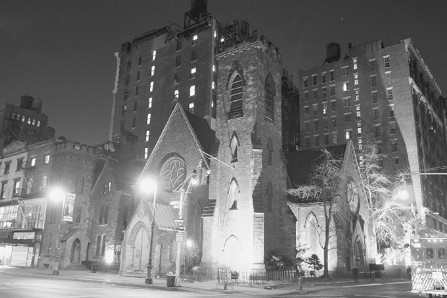By Lawrence Lerner
The owner of the former Episcopal church that once housed the Limelight nightclub and is now home to Avalon wants to turn the building into a mini-mall.
Ashkenazy Acquisition Corp., the building’s landlord, is reportedly reading the writing on the wall as upscale condo projects and restaurants invade the western edge of the Flatiron District, making the 12,000-square-foot club, which has a history of trouble in the neighborhood, evermore the pariah in the increasingly gentrified area.
“We can’t wait till we can convert the church into a retail space,” said Rudy Klotsman, Ashkenazy’s vice president of leasing, who said that a couple of months ago he received instructions from company higher-ups to find another tenant for the Gothic-revival brownstone church on Sixth Ave. at 20th St. “At the end of the day, we want to become a friendly neighbor. We’ve always been looked at as a bad neighbor in the Flatiron and Chelsea, and we’d like to move beyond that.”
But community pressure may not be all that is driving the landlord to test the retail waters by floating the mini-mall concept. Avalon has also been having big financial problems. In mid-September, the Internal Revenue Service closed the club temporarily for nonpayment of taxes to the tune of $125,000, which the club reportedly paid. But on Sept. 28, club promoters reported seeing I.R.S. seizure signs posted throughout the club. As of this week, however, Avalon was semi-open for business once again.
Meanwhile, reports that Avalon will shutter its doors in early 2007 — due to money problems or community concerns — are not necessarily true, according to Klotsman.
“If we have a tenant for the space by the beginning of the year, then yes. If not, then no,” he said, adding that “It also depends on if Avalon has a thriving business or not, whether they can pay the rent.”
Klotsman confirmed that Avalon indeed holds a long-term lease on the space and has “some term left on that lease.” But he added that “there is probably some side agreement within the lease contract that makes it possible to find another tenant,” though he refused to elaborate on the details.
Ashkenazy is considering various plans for the cathedral space, all of them containing some retail element, according to Klotsman. One idea is to get a single tenant downstairs and perhaps a restaurant on the second floor, while turning the existing side-street patio that is now used as a smoking area by Avalon into an outdoor seating area for a restaurant or cafe.
“We’d also be open to a retail tenant downstairs, with office space upstairs,” Klotsman said. “Ideally, though, we’d like to lease to a single tenant and let them do something creative with the space.”
It has been reported that international discount-clothing retailer H&M is the likely main tenant for the space, but according to Klotsman, that is untrue. He added that H&M recently opened a store on Fifth Ave. and 18th St., in the location of the old Daffy’s department store, making them an unlikely suitor.
“We’ve spoken to them but that’s about it. But honestly, we’ve had more leeway with other retailers,” he said. “We’ve had many discussions with Whole Foods, but the space is too complicated for them. We’ve also talked with Borders and with Circuit City, who may be the best possibility so far. We’ll see.”
Seeing the Signs
But turning the church into a retail center would pose a significant challenge, not the least of which is how new tenants would draw customers into the building, the exterior of which is landmarked.
“Sometimes signs are allowed on the outside of landmarked buildings, as long as they’re appropriate, they harmonize with the rest of the building and the 11 [Landmarks] commissioners approve them,” said Lisi DeBourbon, spokesperson for the Landmarks Preservation Commission, which has yet to receive any applications from Ashkenazy for the former church.
As for signage that might go on the grounds surrounding the church, “If it affects the exterior and is out of sync with the rest of the building, it wouldn’t be approved by commissioners,” said DeBourbon. “Backlit signs are not allowed, for instance.”
Also at issue are the perceived incongruity of putting retail in an old church and finding the right tenant fit, which are limiting Klotsman’s options a bit.
“It’s a complicated space and not an easy configuration to turn into retail. If we were dealing with a box building here, it would lend itself to retailers like Foot Locker, Liz Claiborne or Victoria’s Secret,” he said. “But at the end of the day, could you see images of scantily clad women all over the church? The community would be outraged if that happened.”
Not surprisingly, some in the club-going community are incredulous at the thought of the space — which has housed nightclubs since Peter Gatien opened Limelight in 1983 — going retail and think it’s terrible idea.
“There has to be $15 million invested to build a discotheque to that level — going back to Limelight — with so many floors, rooms, bar installations, lighting systems, bathrooms, five dance floors and a state-of-the-art sound system that reaches into every nook and cranny,” said Baird Jones, a longtime nightlife promoter now connected with Webster Hall who is also that venue’s art curator.
“Would the landlord kiss off all of that?” Jones asked. “It just doesn’t make any sense, unless the nightlife business at that location has fallen off so much, and its reputation is so damaged, that no new money would dare come in.”
Nearby residents have certainly expressed their disapproval of the club, citing a host of problems since Limelight re-opened as Avalon three years ago. Laura Michaels, founder of the Flatiron Alliance, has been at the forefront of community complaints.
“No one rises to the occasion to make it work for the neighborhood,” she said. “There are a lot of people milling around outside, a lot of fights, an incredible amount of music postings on scaffolding and poles, and club cards scattered around the streets, which never get swept up. There’s also a lot of tagging going on — graffiti on storefronts and on big, green service mailboxes.”
Michaels believes the landlord may be trying to deal with the new political reality in the neighborhood by floating the mini-mall concept and trying to attract possible tenants.
“Because the neighborhood has gotten more retail and residential, there may be problems going forward for any establishment operating the way this club’s been operating,” Michaels said.
Meanwhile, David Diamond, chairperson of Community Board 5, said that, while Avalon may have a slightly tougher time securing a positive recommendation from the board to renew its liquor license or possibly transfer its ownership because of its checkered past, the board is not trying to send out a negative message to the nightlife industry.
“There have been many complaints about the various operations at this [Avalon’s] particular location, so we’d scrutinize any related transfer-of-ownership applications or liquor-license renewals quite closely. But we’re not anti-club,” said Diamond. “In fact, we try to balance the needs of the business community and residents and look at all the factors. And sometimes, we stay silent and make no recommendation at all.”
Financial woes
But Jones thinks the community issues are far less integral to Avalon’s problems — and Ashkenazy’s bid to go mini-mall — than the club’s financial problems.
“Anyone could come in as a silent partner, pay off the I.R.S. debt and get a liquor-license renewal when the time comes. They can sidestep the community by and large, so I don’t see the community issue being the big one here,” said Jones.
Jones’s business associate, a promoter who goes by the name Cris A.C., ran a Saturday evening party called the Chill Factor at Avalon from early 2004 until summer 2006 and is intimate with the club’s financial woes. While throwing events in Avalon’s Spider Room — its V.I.P. lounge for older patrons that has a separate entrance and dance floor — A.C. saw the club deteriorate around him.
“Me and my staff got our first bounced checks on Dec. 28, 2005. It was the same deal for regular club security and staff,” A.C. said. “I then began paying my staff out of pocket and handed Avalon an invoice, because I didn’t want my staff affected by Avalon’s payroll problems.”
A.C. never got paid, and neither did other promoters. He finally cut his losses in August after racking up $12,000 in unpaid invoices. Meanwhile, between March and August of this year, A.C. witnessed a host of other problems indicating tough financial times for the club.
“The club stopped taking credit cards at one point, which made it impossible for patrons to get a bottle, since no one carries $1,500 around with them for a table and bottle service,” he continued. “And because the club stopped paying its distributors, they were very short of bottles, even though bottle service was required to get into the club,” he said, adding that there was also very little liquor behind the bar — just house vodka, gin and rum that bartenders spread into multiple bottles to give the appearance of a full bar stocked with top-shelf liquor.
According to A.C., security at Avalon also became a huge problem because of nonpayment.
“Starting in March, after the legitimate security company bolted, the club began to employ non-licensed, non-insured, non-bonded security, which made the club really disorganized and chaotic,” he said. “It was like there were new security guards every night there for a while.”
Meanwhile, last Tuesday night, the beat went on at Avalon, as a line of revelers stretched down Sixth Ave. and around the corner onto 20th St. Most of the patrons, huddling tightly together in the evening cold, seemed indifferent to the prospect of the famed club going mini-mall.
Dana Corey, a 25-year-old bartender from Queens, summed it up nicely.
“I’ve been here a couple of times, but this club never did much for me,” he said. “I’m into dive bars. Give me a good Irish bar, some cheap booze and a jukebox, and I’m all set.”




































